Ever wanted to take over the world with airships? Now’s your chance. Zeppelin Attack is a game from Evil Hat Productions set in the world of Spirit of the Century. You and your opponents play the evil masterminds bent on world domination—Der Blitzmann, Gorilla Khan, Jacqueline Frost, or the Walking Mind—sending out your zeppelins to do your bidding. (I mentioned this briefly in my last Kickstarter roundup, but I’ll get into more details here.)
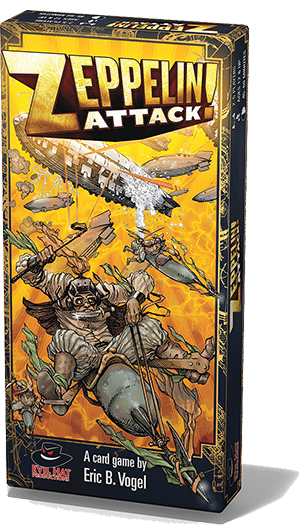 At a glance: Zeppelin Attack is for 2-4 players, ages 12 and up, and takes about 45-60 minutes to play. The pledge price for the game is $30 including shipping in the US (higher elsewhere), or $10 for the print and play files. The pledge levels also include a print-and-play game called Zeppelin Conquest, which I talk about below.
At a glance: Zeppelin Attack is for 2-4 players, ages 12 and up, and takes about 45-60 minutes to play. The pledge price for the game is $30 including shipping in the US (higher elsewhere), or $10 for the print and play files. The pledge levels also include a print-and-play game called Zeppelin Conquest, which I talk about below.
Components:
The game consists of 112 cards, which may seem slim for a deck-building game, but there’s more attacking and hand-management than building.
The cards are designed pretty well to make the game easy to navigate, and the artwork by Christian St. Pierre (who has also done art for other Spirit of the Century products) has a great pulp-adventure feel to it, with plenty of humor. Since my copy of the game was a demo prototype, I can’t really speak to the final print quality.
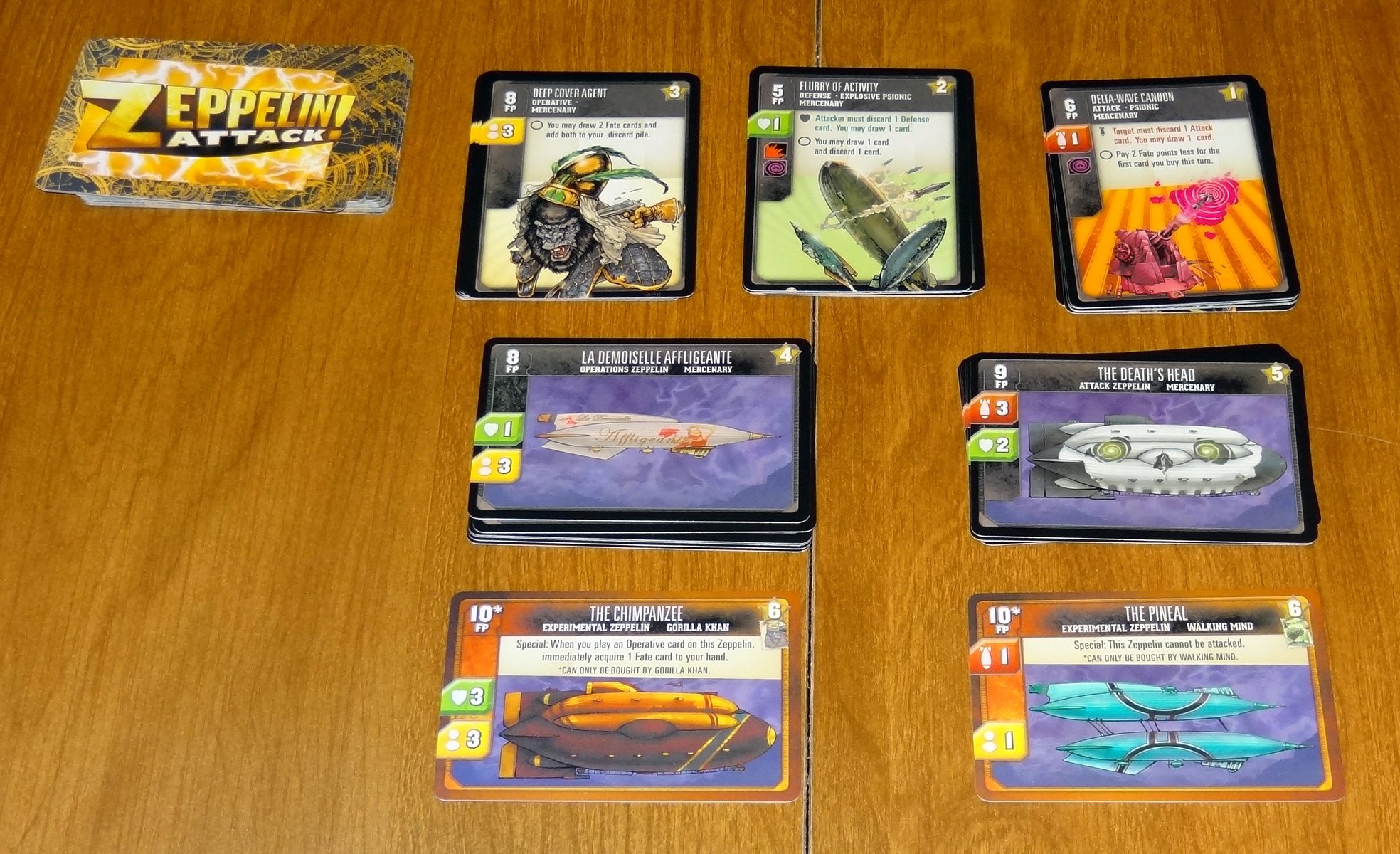
How to Play
The rules are available for download here, and the Print and Play is available immediately if you pledge at least a buck.
The object of the game is to score the most points—by buying cards and scoring battle points with successful attacks—by the time 3 of the mercenary decks run out.
Each player gets the deck associated with their character and two Fate cards (valued 3 and 4). The flagship is placed in front of them on the table, the Experimental Zeppelin is placed out in the center of the table (available for purchase later), and the rest of their cards are shuffled together to form a deck. The remaining Fate cards are shuffled and placed face-down in a deck, and then all the mercenary cards are sorted by type (Attack, Defense, Operative, Attack Zeppelins, Operations Zeppelins), shuffled, and placed face up in the center of the table.
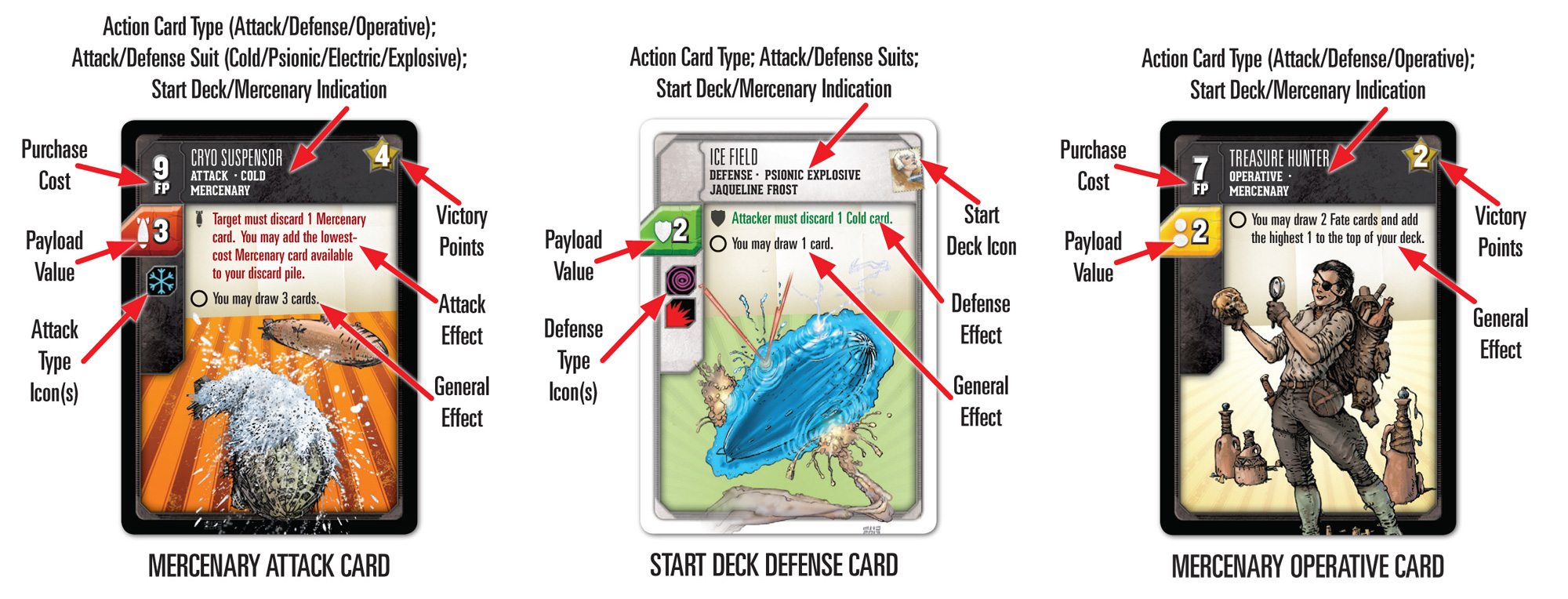
Everyone has a hand of five cards to start. On your turn, you may play zeppelins in front of you, and each zeppelin you have in play lets you play one action on it—but only if the action card matches the type of zeppelin. Your flagship can handle any of the three actions, but the mercenary zeppelins give you either Attack/Defense or Defense/Operative. Attacks let you attack an opponent’s zeppelin, and Operatives let you gain Fate cards, which are the game’s currency.

When you attack another player, you pick one of their zeppelins and play an attack card (on one of your zeppelins with the attack ability). The other player can then respond with a defense card that matches the weapon type on your card. Successfully defending means they get the defense effect of their card and the general effect, and then the attacker only gets the general effect on their attack card. If the player cannot defend, then the zeppelin is discarded (unless it’s a flagship), the attacker gets the attack and general effect on their card, and they also get a Battle Point—that’s any top card of a mercenary stack placed face-down under their flagship.
The abilities on the zeppelins are numbered—for all but the flagship, you can “overload” the zeppelin by playing a higher number than the allowance, but it means that your zeppelin will be discarded. Sometimes you’ll have to decide whether a card is valuable enough to discard a zeppelin to play it.
Once you’re done playing cards, you may then spend Fate Points in your hand to buy any number of cards from the mercenary decks—spent cards go back into a discard pile in the center of the table, so you’ll have to earn some more Fate Points to buy more later. Finally, you may discard or keep any of your unplayed cards, and then draw back up to five cards. All the action cards you’ve played this turn (on your zeppelins) get discarded, and zeppelins stay out unless they were overloaded.
There are a couple of other rules—for instance, some Fate Points cards have effects that come into play when they’re acquired. Also, whenever you buy an action card (attack, defense, operative) you may purge a card from your hand or discard pile and put it under your flagship as a Battle Point—that both trims out cards you don’t want and increases your score.
That’s basically it—the game continues until three of the decks run out, and then you finish that round of play. You get 1 point for each Battle Point under your flagship, as well as the indicated number of points for cards you’ve purchased. The player with the most unspent Fate Points also gets a small bonus. Highest score wins.
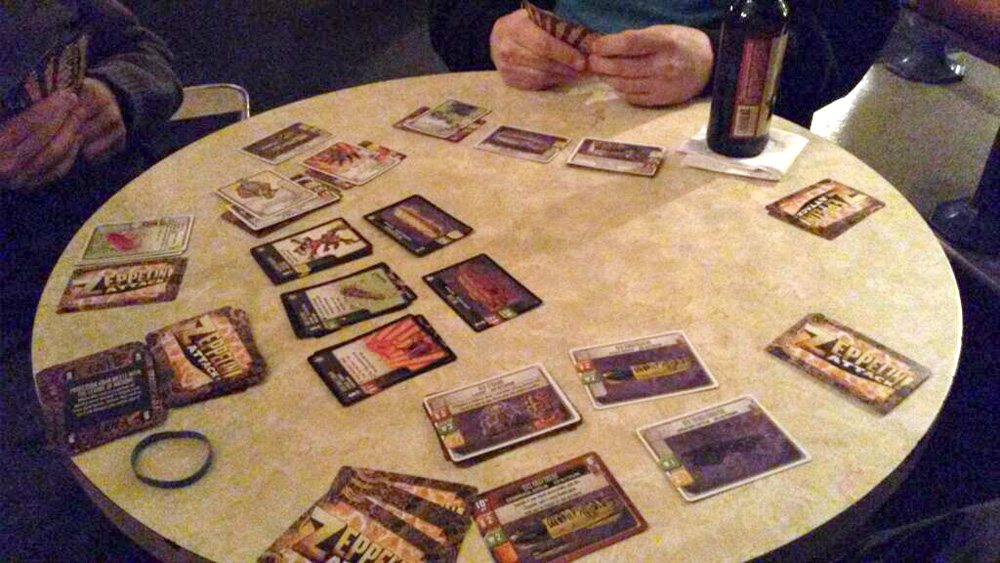
The Verdict
I’m not entirely familiar with the Spirit of the Century world—I did back the Race to Adventure game back in 2012 because I liked the concept but haven’t checked out any of the fiction surrounding it all. But you don’t really need much back story to enjoy a game about zeppelins attacking each other, do you?
The designer of Zeppelin Attack, Eric Vogel, is also behind a few other games that I’ve really enjoyed like Cambria and Romans Go Home, so I was interested to see his take on a deck-building game. His specialty seems to be squeezing a lot of strategic depth into what appears to be a pretty simple game, and Zeppelin Attack is no different.
Your choices seem limited at first: play one action per zeppelin, get your zeppelins out there so you get more actions, and buy some more cards. But pretty soon you realize the importance of the choices you make: do you hang onto attack cards at the end of your turn, hoping to launch multiple attacks next round (thus having a better chance of getting past an opponent’s defenses) or do you save up defense cards instead? If you do the latter and you don’t get attacked, then you’ll find yourself on the next turn not having a whole lot of actions. Likewise, you could store up Fate Points to buy that shiny new zeppelin, but it leaves you vulnerable to attacks and reduces the number of attacks you can make.
When you buy cards, you really need to make sure that you’re acquiring zeppelins and actions that are compatible; it does you no good to have an entire hand of attack cards if you only have one attack zeppelin. Also, that option to purge cards when you buy an action card is very handy—as long as don’t dump defense cards you’ll need against your opponent’s fancy guns. When you acquire Battle Points for a successful attack, you get to take cards from the mercenary decks—that runs the deck out, bringing the end of the game closer, but it also puts that particular card out of commission for the game. That makes it a good way to neutralize a card that you can’t afford but don’t want your enemies to obtain.
In my plays, I did find that the two-player game felt a little unbalanced and I’d recommend it for 3 or 4 players. With only two, it’s possible for one player to get ahead, and there doesn’t seem to be much of a catch-up mechanism. The player with more zeppelins can take more actions, get more money, make more attacks, buy better defense, and so on—while the other player struggles to build up anything. With three or more, people can gang up on the leader a little bit.
The four characters have slightly different abilities, though the starting decks are more or less equivalent. The main difference comes in the Experimental Zeppelins—each player has one available for purchase (you can’t buy somebody else’s) and they’re generally worth the 10 Fate Point cost if you can afford them. I haven’t seen nearly as many games played as Vogel, but so far I’m having a hard time overcoming Gorilla Khan’s Chimpanzee zeppelin, which lets you acquire Fate Points at an alarming rate. Vogel assures me that there are ways to counter this strategy, so I’m going to keep working at that.
Overall, I can see Zeppelin Attack is a game that will take some time to master, and even though it looks like a very small number of cards for a deck-building game, it offers a lot of good player interaction and forces you to make tough choices throughout the game. Now the question is: is it worth $30? Well, you can read through all of the updates that explain how Evil Hat’s Fred Hicks figured out pledge amounts, total funding goal, and so on—he’s pretty transparent about how all the numbers work out. I think it’s a game that will be satisfying to play, but $30 for the number of cards might seem higher than what you’re used to, depending on whether you generally include shipping costs in your calculations. You can pledge for multiple copies to save on shipping, though, and that may bring down the price to a more palatable level.
On top of the base game, though, you’ll also get the print and play files immediately so you can start playing already. And you’ll also get a print-and-play of Zeppelin Conquest, a two-player game (also by Eric Vogel). To help you decide, here’s a brief overview of that game as well.

The rules for Zeppelin Conquest are available here. Each player gets a deck of cards, either as Rocket Red or Princess Cyclone. There are three target cards in the center of the table, each with three locations.
You play cards face-down next to the cities over the course of three rounds, so that each player has three cards next to each city. Then they’re flipped over and scoring is resolved. For each location on a target card, there’s a scoring condition; for example, most soldiers = 5 VP, or most zeppelins and at least 1 soldier = 3 VP. There are some that subtract VPs, and some that require you to be first to play a Doomsday device. You compare the rows of symbols corresponding to each target, and score accordingly.
It’s short and sweet, but again has room for interesting decisions. Since cards are played face-down, you’ll find it’s tough to remember all of the cards you’ve already played. I have a lot of zeppelins already, but did I play the required soldier? Should I play this card that will cost me a point on the middle location because I might be able to win this 7 VP location with the Doomsday Device? Do I put all of my strength behind fewer locations, or try to cover as many bases as possible?
While you won’t get a hard copy of Zeppelin Conquest (except by making it yourself), if you do back the Kickstarter at a $10 or higher level, you’ll get it included as a PDF, and it’s definitely worth printing out and trying.
Between the Attack and Conquest, that may be enough to satisfy your zeppelin fix for a little while. If not … there’s more on the way. For more information, visit the Zeppelin Attack Kickstarter page.
Disclosure: Thanks to Eric Vogel for providing a demo prototype of Zeppelin Attack and a print and play version of Zeppelin Conquest for this review!



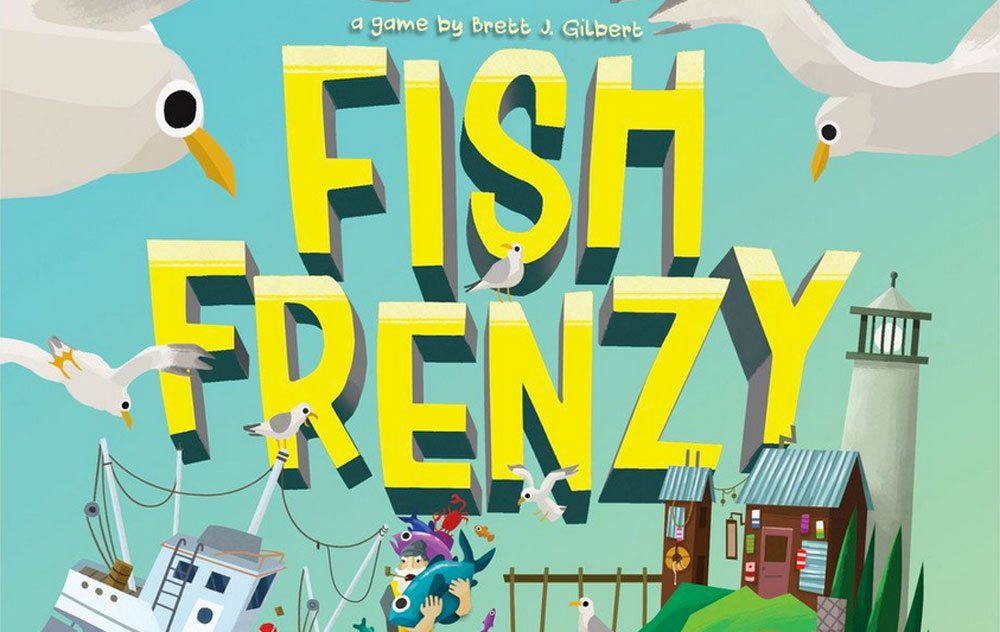
Great Review! However, one sentence might be a bit confusing for readers:
“When you acquire Battle Points for a successful attack, you get to take cards from the mercenary decks—that runs the deck out, bringing the end of the game closer, but it also puts that particular card out of commission for the game.”
I think what you meant was this: “When you buy a new mercenary “Action” card from the supply, you can remove an “Action” card from your hand (or discard pile) to become an additional Battle Point by putting it permanently under you flagship card.” Right?
Or did you mean this:” When you acquire **Fate** Points by successfully using abilities on your operative cards and other cards, you get to take cards from the mercenary decks—that runs the deck out, bringing the end of the game closer.”